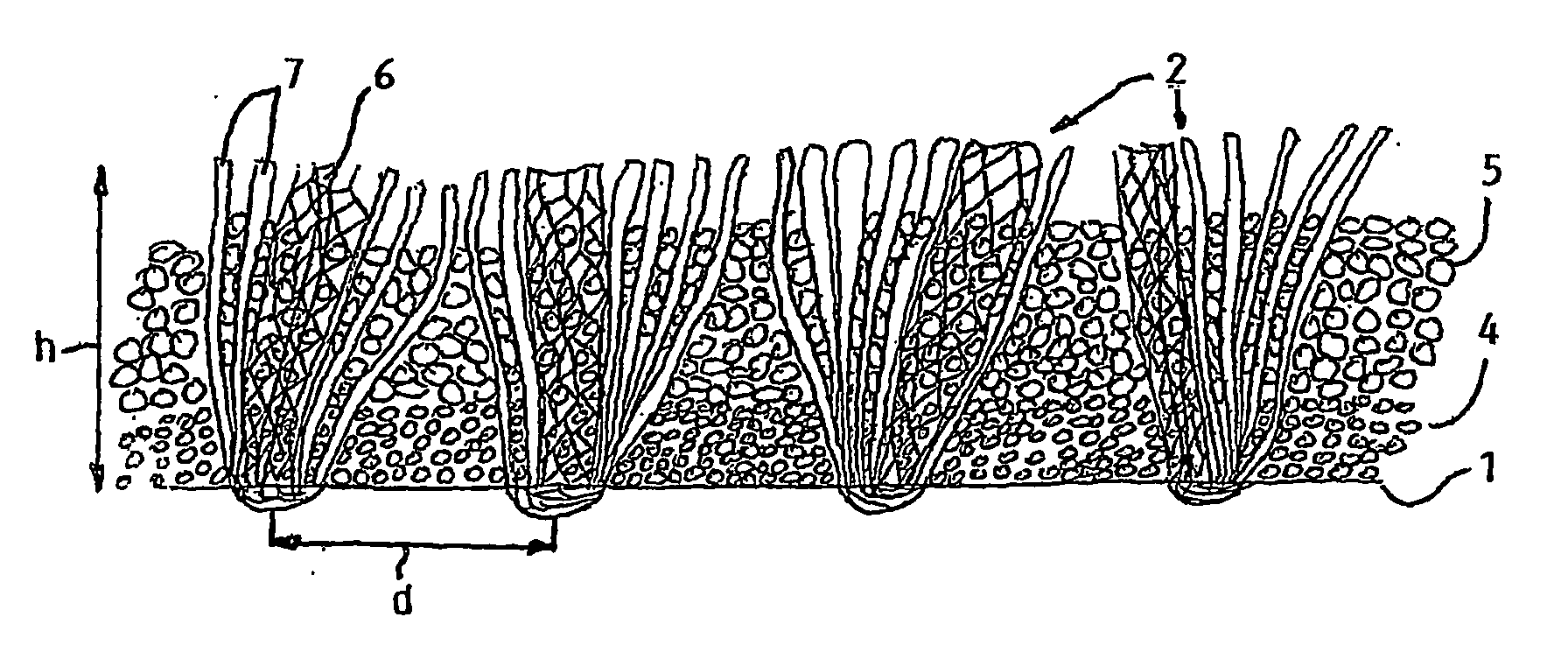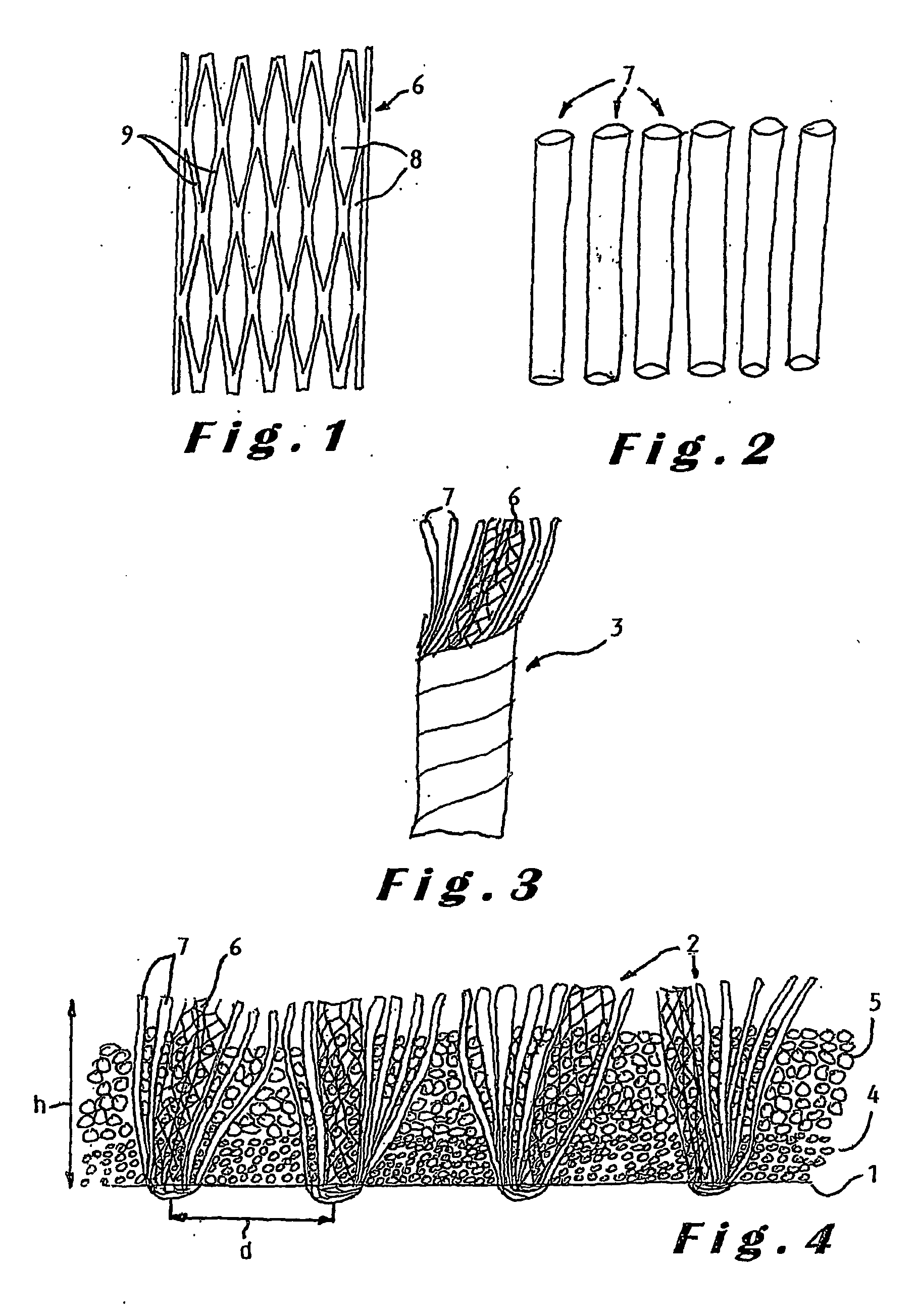Synthetic turf
a synthetic turf and rubber technology, applied in the field of synthetic turf, can solve the problems of limited life span, insufficient resilience or shock absorption of synthetic turf use, and inability to be reused, and achieve the effect of reducing the coefficient of friction, reducing the number of burns, and reducing the resilience of polyethylene yarns
- Summary
- Abstract
- Description
- Claims
- Application Information
AI Technical Summary
Benefits of technology
Problems solved by technology
Method used
Image
Examples
example 1
[0056] A composite yarn 3 was first made by twining one fibrillated yarn 6 around six monofilament yarns 7. The fibrillated yarn had a yarn number of 6600 dtex and a thickness of 80 μm. The slits were arranged on such mutual distances d that the filaments had varying widths, more particularly width varying between about 0.1 mm and about 1.2 mm. The monofilament yarns each had a yarn number of 1400 dtex, a thickness of 160 μm and a width of 1.4 mm. The yarn number of the composite yarn comprised 15000 dtex. The different yarns were all made of polyethylene containing UV and heat stabilisers and a green pigment. The composite yarn was tufted on a backing layer consisting of a woven polypropylene layer and a glass fibre netting. The needle distance of the tufting machine was set at ⅝″. The tufts had an average height h of about 5 cm. A latex adhesive was applied on the back of the backing layer to fix the tufts. The achieved synthetic grass is illustrated in FIG. 4. In the cross-sectio...
example 2
[0057] A composite yarn was made by twining two monotapes around four monofilament yarns. The monotape yarn had a yarn number of 2200 dtex and a thickness of 100 μm. The width of the monotape yarn was 2.5 mm. The monofilament yarn had a yarn number of 1400 dtex and a thickness of 160 μm. The width of the monofilament was 1.4 mm. The yarn number of the composite yarn was 10000 dtex. The composite yarn was tufted on a backing layer consisting of a woven polypropylene layer and a glass fibre netting. A latex adhesive was applied on the back of the backing layer to fix the tufts. The synthetic turf immediately resembled natural grass, i.e. no post-fibrillation or wear was necessary to achieve this look.
[0058] From the above given description of some preferred embodiments of the synthetic turf according to the invention, it will be clear that further modifications can be applied thereto provided they still fall within the scope of the invention as determined by the annexed claims.
[0059...
PUM
| Property | Measurement | Unit |
|---|---|---|
| Fraction | aaaaa | aaaaa |
| Fraction | aaaaa | aaaaa |
| Fraction | aaaaa | aaaaa |
Abstract
Description
Claims
Application Information
 Login to View More
Login to View More - R&D
- Intellectual Property
- Life Sciences
- Materials
- Tech Scout
- Unparalleled Data Quality
- Higher Quality Content
- 60% Fewer Hallucinations
Browse by: Latest US Patents, China's latest patents, Technical Efficacy Thesaurus, Application Domain, Technology Topic, Popular Technical Reports.
© 2025 PatSnap. All rights reserved.Legal|Privacy policy|Modern Slavery Act Transparency Statement|Sitemap|About US| Contact US: help@patsnap.com


